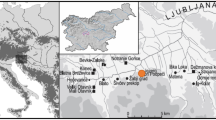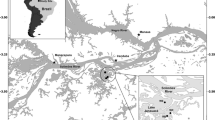Abstract
Tropical floodplain wetlands are favorable environments for the growth of aquatic macrophytes and palustrine plants. Such plants and phytoplankton are usually the key sources of autochthonous detritus within floodplain lakes. An experiment was conducted in order to compare the production of methane (CH4) and carbon dioxide (CO2) from anaerobic decomposition of Salvinia auriculata. The incubations were prepared and maintained (138 d) at 4 different temperatures (15.3, 20.8, 25.7 and 30.3 °C), and the daily rates of CH4 and CO2 were measured by gas chromatography. Periodically, the dissolved organic carbon, electrical conductivity, pH and redox potential were also measured. The anaerobic mineralization of S. auriculata was a sensitive process with respect to temperature, and CH4 was the minor product (CH4 yield: 0 to 5.1 % of C-emissions). The Q10 calculated for mineralization was 1.16, and. after 138d, the CO2 yields were closed (average: 23.6 %). The CH4 was a secondary end product of S. auriculata mineralization, making CO2 the main greenhouse gas produced from this source. The increase in temperature should favor the formation of CH4 and shorten the time required for their formation. However, due to the large difference between the yields, CO2 should remain the main end product of decomposition.


Similar content being viewed by others
References
Ballester MVR, Santos JE (2001) Biogenic gases (CH4, CO2 and O2) distribution in a riverine wetland system. Oecologia Brasiliensis 9:21–31
Bianchini I Jr, Cunha-Santino MB (2014) Dynamics of colonization and the collapse of a macrophyte community during the formation of a tropical reservoir. Fundamental and Applied Limnology 184:141–150
Bianchini I Jr, Cunha-Santino MB, Romeiro F, Bitar AL (2010) Emissions of methane and carbon dioxide during anaerobic decomposition of aquatic macrophytes from a tropical lagoon (São Paulo, Brazil). Acta Limnolica Brasiliensia 22:157–164
Bianchini I Jr, Cunha-Santino MB, Panhota RS (2011) Oxygen uptake from aquatic macrophyte decomposition from Piraju Reservoir (Piraju, SP, Brazil). Brazilian Journal of Biology 71:27–35
Bianchini I Jr, Cunha-Santino MB, Milan JAM, Rodrigues CJ, Dias JHP (2015) Model parameterization for the growth of three submerged aquatic macrophytes. Journal of Aquatic Plant Management 53:64–73
Bini LM, Thomaz SM, Murphy KJ, Camargo AFM (1999) Aquatic macrophyte distribution in relation to water and sediment conditions in the Itaipu Reservoir Brazil. Hydrobiologia 415:147–154
Bloom AA, Palmer PI, Fraser A, Reay DS (2012) Seasonal variability of tropical wetland CH4 emissions: the role of the methanogen-available carbon pool. Biogeosciences 9:2821–2830
Boschilia SM, Thomaz SM, Piana PA (2006) Plasticidade morfológica de Salvinia herzogii (de La Sota) em resposta à densidade populacional. Acta Scientiarum Biological Sciences 28:35–39
Bowie GL, Mills WB, Porcella DB, Campbell CL, Pagenkopf JR, Rupp GL, Johnson KM, Chan PWH, Gherini SA, Chamberlin CE (1985) Rates, constants, and kinetics formulations in surface water quality modeling, 2nd ed. United States Environmental Protection Agency, EPA/600/3-85/040. Government Printing Office, Athens
Camargo AFM, Esteves FA (1995) Influence of water level variation on fertilization oxbow lake of Rio Mogi-Guaçu, State of São Paulo, Brazil. Hydrobiologia 299:185–193
Cunha-Santino MB, Bianchini I Jr (2007) Cellulase activities during decomposition of a submerged aquatic macrophyte (Utricularia breviscapa): a microcosm assay. Brazilian Journal of Microbiology 38:230–236
Cunha-Santino MB, Bianchini I Jr (2008) Carbon cycling potential from Utricularia breviscapa decomposition in a tropical oxbow lake (São Paulo, Brazil). Ecological Modelling 218:375–382
Cunha-Santino MB, Bianchini I Jr (2013) Tropical macrophyte degradation dynamics in freshwater sediments: relationship to greenhouse gas production. Journal of Soils and Sediments 13:1461–1468
Cunha-Santino MB, Bianchini I Jr, Gianotti EP, Silva EL (2006) Degradação anaeróbia de macrófitas aquáticas da lagoa do Infernão: metanogênese. In: Santos JE, Pires JSR, Moschini LE (eds) Estudos integrados em ecossistemas – Estação Ecológica de Jataí. São Carlos: EDUFSCar. 4:143–158
Debusk WF, Reddy KR (2005) Litter decomposition and nutrient dynamics in a phosphorus enriched everglades marsh. Biogeochemistry 75:217–240
Duke ST, Francoeur SN, Judd KE (2015) Effects of Phragmites australis invasion on carbon dynamics in a freshwater marsh. Wetlands 35:311–321
El-Shinnawi MM, Alaa El-Din MN, El-Shimi SA, Badawi MA (1989) Biogas production from crop residues and aquatic weeds. Resources, Conservation and Recycling 3:33–45
Erhagen B, Öquist M, Sparrman T, Haei M, Ilstedt U, Hedenström M, Schleucher J, Nilsson MB (2013) Temperature response of litter and soil organic matter decomposition is determined by chemical composition of organic material. Global Change Biology 19:3858–3871
Fernández OA, Sutton DL, Lallana VH, Sabbatini MR, Irigoyen FH (1990) Aquatic weeds problems and management in South and Central America. In: Pieterse AH, Murphy KJ (eds) Aquatic weeds. The ecology and management of nuisance aquatic vegetation. Oxford University Press, New York, pp 406–425
Fushita AT, Santos JE (2015) Landscape heterogeneity and complexity in river floodplain ecosystems. Sky Journal of Soil Science and Environmental Management 4:94–104
Gedney N, Cox PM, Huntingford C (2004) Climate feedback from wetland methane emissions. Geophysical Research Letters 31, L20503
Gerardi MH (2003) The microbiology of anaerobic digesters. John Wiley & Sons, New Jersey
Gianotti EP, Santos JE (2000) Estimativas das taxas de desnitrificação e da densidade de bactérias desnitrificantes na lagoa do Infernão (Estação Ecológica de Jataí, Luiz Antônio, SP). In: Santos JE, Pires JSR (eds) Estudos Integrados em Ecossistemas - Estação Ecológica de Jataí. RiMa Editora, São Carlos, pp 667–674
Gopal B (1990) Nutrient dynamics of aquatic plant communities. In: Gopal B (ed) Ecology and management of aquatic vegetation in the Indian subcontinent. Kluwer, Dordrecht, pp 177–197
Hammer Ø, Harper DAT, Ryan PD (2001) PAST: paleontological statistics package for education and data analysis. Palaeontologica Electronica 4:1–9
Hanamachi Y, Hama T, Yanai T (2008) Decomposition process of organic matter derived from freshwater phytoplankton. Limnology 9:57–69
IPCC (2013) Climate Change 2013: The Physical Science Basis. Contribution of Working Group I to the Fifth Assessment Report of the Intergovernmental Panel on Climate Change In: Stocker TF, Qin D, Plattner GK, Tignor M, Allen SK, Boschung J, Nauels A, Xia Y, Bex V, Midgley PM (eds.). Cambridge, Cambridge University Press
Jacono CC, Davern TR, Center TD (2001) The adventive status of Salvinia minima and S. molesta in the Southern United States and the related distribution of the weevil Cyrtobagous salviniae. Castanea 66:214–226
Junk WJ, Wantzen KM (2004) The flood pulse concept: new aspects approaches and applications – an update. In: Welcomme RL, Petr T (eds.) Proceedings of the Second International Symposium on the Management of Large Rivers for Fisheries: Vol. 2. Food and Agriculture Organization & Mekong River Commission. FAO Regional Office for Asia and the Pacific, Bangkok, pp 117–140
Junk WJ, Bayley PB, Sparks RE (1989) The flood pulse concept in river - floodplain systems. Canadian Special Publication of Fisheries and Aquatic Sciences 106:110–127
Junk W, An S, Finlayson C, Gopal B, Květ J, Mitchell S, Mitsch W, Robarts R (2013) Current state of knowledge regarding the world’s wetlands and their future under global climate change: a synthesis. Aquatic Sciences 75:151–167
Kätterer T, Reichstein M, Andrén O, Lomander A (1998) Temperature dependence of organic matter decomposition: a critical review using literature data analyzed with different models. Biology and Fertility of Soils 27:258–262
Leschine SB (1995) Cellulose degradation in anaerobic environments. The Annual Review of Microbiology 49:399–426
Lolis SL (2008) Macrófitas aquáticas do reservatório Luís Eduardo Magalhães - Lajeado - Tocantins: biomassa, composição da comunidade e riqueza de espécies. Ph.D. Thesis. Universidade Estadual de Maringá
Martins D, Costa NV, Terra MA, Marchi SR (2008) Caracterização da comunidade de plantas aquáticas de dezoito reservatórios pertencentes a cinco bacias hidrográficas do Estado de São Paulo. Planta Daninha 26:17–32
Megonigal JP, Hines ME, Visscher PT (2004) Anaerobic metabolism: Linkages to trace gases and aerobic processes. In: Schlesinger WH (ed) Biogeochemistry. Elsevier-Pergamon, Oxford, pp 17–424
Melack JM, Hess LL, Gastil M, Forsberg BR, Hamilton SK, Lima IBT, Novo EMLM (2004) Regionalization of methane emissions in the Amazon Basin with microwave remote sensing. Global Change Biology 10:530–544
Merritt RW, Lawson DL (1992) The role of leaf litter macroinvertebrates in streams-floodplain dynamics. Hydrobiologia 248:65–77
Mitchell DS, Tur NM (1975) The rate of growth of Salvinia molesta (S. auriculata Auct.) in laboratory and natural conditions. Journal of Applied Ecology 12:213–225
Neiff AP, Neiff JJ, Casco SL (2006) Leaf litter decomposition in three wetland types of the Paraná River Floodplain. Wetlands 26:558–566
Nozhevnikova AN, Holliger C, Ammann A, Zehnder AJB (1997) Methanogenesis in sediments from deep lakes at different temperatures (2–70 °C). Water Science and Technology 36:57–64
O’Sullivan C, Rounsefell B, Grinham A, Clarke W, Udy J (2010) Anaerobic digestion of harvested aquatic weeds: water hyacinth (Eichhornia crassipes), cabomba (Cabomba Caroliniana) and salvinia (Salvinia molesta). Ecological Engineering 36:1459–1468
Parsons SA, Congdon RA, Lawler IR (2014) Determinants of the pathways of litter chemical decomposition in a tropical region. New Phytologist 203:873–882
Petracco P (2006) Efeito das variáveis abióticas na produção primária de Egeria najas e Utricularia breviscapada lagoa do Óleo (Estação Ecológica de Jataí, Luiz Antônio, SP). Ph.D. Thesis. Universidade Federal de São Carlos
Pott VP, Pott A (2000) Plantas aquáticas do Pantanal. Embrapa, Brasília
Reddy KR, DeLaune R (2008) Biogeochemistry of wetlands. Science and applications. CRC Press, Boca Raton
Romeiro F, Bianchini I Jr (2006) Anaerobic decomposition of different parts of Scirpus cubensis: kinetics and gases productions. Acta Limnologica Brasiliensia 18:145–152
Sciessere L (2011) Ação das enzimas extracelulares na decomposição de macrófitas aquáticas. Ph.D. Thesis. Universidade Federal de São Carlos
Sciessere L, Cunha-Santino MB, Bianchini I Jr (2011) Cellulase and xylanase activity during the decomposition of three aquatic macrophytes in a tropical oxbow lagoon. Brazilian Journal of Microbiology 42:909–918
Segers R (1998) Methane production and methane consumption: a review of processes underlying wetland methane fluxes. Biogeochemistry 41:23–51
Tanaka RH, Cardoso LR, Martins D, Marcondes DAS, Mustafá AL (2002) Ocorrência de plantas aquáticas nos reservatórios da Companhia Energética de São Paulo. Planta Daninha 20:99–111
Thomaz SM, Pagioro TA, Bini LM, Murphy KJ (2006) Effect of reservoir drawdown on biomass of three species of aquatic macrophytes in a large sub-tropical reservoir (Itaipu, Brazil). Hydrobiologia 570:53–59
Thomaz SM, Bini LM, Souza MC, Kita KK, Camargo AFM (1999). Aquatic macrophytes of Itaipu Reservoir, Brazil: survey of species and ecological considerations. Brazilian Archives of Biology and Technology 42:15–22
Van Geest GJ, Coops H, Roijackers RMM, Buijse AD, Scheffer M (2005) Succession of aquatic vegetation driven by reduced water-level fluctuations in floodplain lakes. Journal of Applied Ecology 42:251–260
Wang Z, Zeng D, Patrick WH (1996) Methane emissions from natural wetlands. Environmental Monitoring and Assessment 42:143–161
Webster JR, Benfield EF (1986) Vascular plant breakdown in freshwater ecosystems. Annual Review of Ecology, Evolution, and Systematics 17:567–594
Winton RS, Richardson CJ (2015) The effects of organic matter amendments on greenhouse gas emissions from a mitigation wetland in Virginia’s Coastal Plain. Wetlands 35:969–979
Acknowledgments
The authors would like to thank the São Paulo Research Foundation (FAPESP proc. n°: 2007/002683-7; 2007/08602-9) and the Brazilian National Council for Scientific and Technological Development for the scholarships (CNPq proc. n°: 150169/2004-3; 305263/2014-5). The authors are also grateful to Dr. Alberto C. Peret (DHb-UFSCar) for helping with the statistical analysis.
Author information
Authors and Affiliations
Corresponding author
Rights and permissions
About this article
Cite this article
Bianchini, I., da Cunha-Santino, M.B. CH4 and CO2 from Decomposition of Salvinia auriculata Aublet, a Macrophyte with High Invasive Potential. Wetlands 36, 557–564 (2016). https://doi.org/10.1007/s13157-016-0765-4
Received:
Accepted:
Published:
Issue Date:
DOI: https://doi.org/10.1007/s13157-016-0765-4




